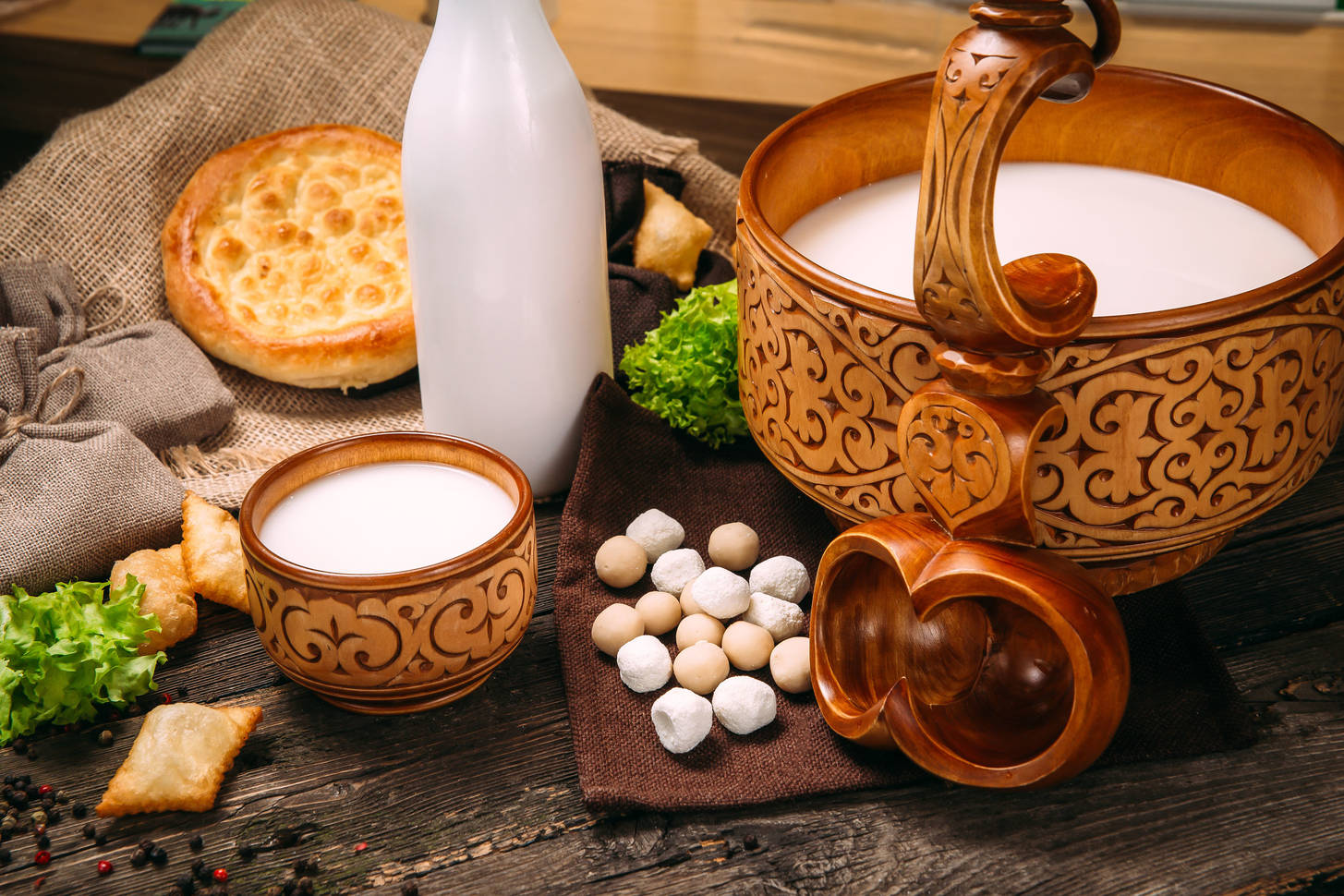ASTANA – From fresh milk to its fermented state and finally as a sublimated powder, scientists reveal why mare’s milk should be on everyone’s plate, as they addressed the scientific conference on Sept. 11 in Astana as part of the fifth World Nomad Games.
Mare’s milk – food with a long history
Horses have long been a valued part of nomadic culture due to their hardiness and mobility, allowing nomads to travel long distances. But the value they have brought to humankind has, for a long time, extended beyond carrying people from place to place.
Mare’s milk, a staple in human diets for over 5,000 years, continues to reveal surprising health benefits. Recent scientific studies suggest it can help treat a range of illnesses, including chronic digestive disorders, diabetes, and even cirrhosis.
“A team of local scientists led by Victor Seibert and British archaeologists reported that horses were domesticated about 3,500 years BC in the territory of northern Kazakhstan, in the settlement of Botai. That’s 5,500 years ago. The traces of mare’s milk fat on ceramic dishes were found there, providing evidence that mare’s milk was used as food. It was not only adults who drank the milk, but it was also given to children,” said Bakytzhan Bimbetov, doctor of medical sciences and chief gastroenterologist at the Medical Center Hospital of the Presidential Affairs Administration of Kazakhstan.
According to him, historical records suggest that mare’s milk’s nutritional and health benefits eventually gained recognition beyond its region of origin.
“In the early 20th century, mare’s milk was so popular in Germany it was delivered door-to-door. It then spread widely in Belgium, France, the Netherlands and Norway,” he said.
“In Central Asia, mare’s milk is one of the food staples. In Mongolia, Kazakhstan and Kyrgyzstan, mare’s milk is fermented in a bag made from horse skin to create a sour drink. After a few days of fermentation, it transforms into a frothy, tangy beverage known as kymyz. In Mongolia, it is called airak,” he said.
Recently discovered benefits of mare’s milk
Those who consumed mare’s milk in the past were ahead of their time, as modern science has uncovered its significant therapeutic benefits, particularly in treating chronic digestive diseases. Notably, mare’s milk has been found to be effective against metabolism-associated hepatitis.

Bakytzhan Bimbetov, chief gastroenterologist at the Medical Center Hospital of the Presidential Affairs Administration, presented findings of his research on mare’s milk benefits for treating hepatitis. Photo credit: Aibarshyn Akhmetkali/The Astana Times
In his study, Bimbetov observed that mare’s milk has been shown to reduce pain and lower blood cytolysis levels in hepatitis patients. As a result, it can be used as a complementary treatment to enhance the effectiveness of conventional therapies for hepatitis.
“After treatment in main groups 1 and 2—those consuming saumal [mare’s milk] alone and saumal combined with Ursosan [Ursodeoxycholic acid]—we observed amazing results. As you see, in both groups, the pain syndrome completely disappeared. However, in the third group, which received only Ursosan, a mild pain syndrome persisted,” said Bimbetov.
Mare’s milk also holds significant therapeutic potential for diabetes, offering promising benefits in managing the disease. “The same research shows that in people who had an increase in glucose tolerance, that is, a slight increase in glucose, it has decreased,” said Bimbetov.
Because of its high albumin content, it has also been shown to reduce the dose and frequency of eating. It helps to reduce cholesterol levels and normalizes blood sugar.
“These findings suggest that mare’s milk can serve as a fundamental therapy for digestive diseases, particularly as a natural source of albumin. In cases of liver cirrhosis, albumin is typically administered intravenously, but with mare’s milk, individuals can naturally obtain albumin through regular consumption,” he added.
Another key benefit of mare’s milk is its positive impact on the immune system. Rich in immunological compounds, it helps protect against infections while also providing a high mineral content and significant levels of essential vitamins.
“Mare’s milk is a good source of fat-soluble vitamins, especially D and K. The study shows that mare’s milk not only contains the usual trace elements we know, but here we see aluminum, cobalt, manganese, chromium, lithium, molybdenum, strontium, and even francium is present,” said Bimbetov.
“In addition, we obtained additional clinical benefits from using mare’s milk. These included overall improved well-being, an increase in body tone, better sleep quality, enhanced physical strength and endurance, weight loss, improved potency in men, and a boost of immunity. Notably, the study was conducted during the winter, and none of the participants reported catching colds,” he added.
Bimbetov recommends regularly consuming mare’s milk to support overall health. However, he advises caution for those who are lactose intolerant.
Although fresh mare’s milk is highly perishable and can only be consumed within three to four hours of milking, modern sublimation techniques enable it to be stored for extended periods without losing its qualities.
“The process of sublimation takes place at a low temperature of 55 Celcius degrees with the use of vacuum, which maximizes the preservation of the qualitative composition of mare’s milk and its therapeutic properties,” said Bimbetov.
Nomadic nutrition advantages
Marina Rosenstein, a nutritionist, dietitian, and member of the American Nutrition Association (ANA), highlighted research she participated in, revealing that despite relying solely on animal-based products, nomadic cultures were still able to maintain a healthy lifestyle.
“Our study showed that nomads did not consume any plant-based food, not at all. They believed that everything that grows on the ground is for the sheep and the horse, and if you pick it off the ground, that’s shamanism,” she said.
“We investigated the relationship between ethnic dietary patterns and dyslipidemia. There was no concept of metabolic syndrome back then. And we were interested in where and how the nomads of Central Asia and the far north obtained essential nutrients, which can only be sourced from plants. They got it from horse by-products,” said Rosenstein.
It is no wonder, then, as Rosenstein points out, that research shows a low prevalence of cardiovascular diseases in nomadic communities. This contrasts sharply with modern society’s rising rates of heart disease, driven by poor diets and stressful, sedentary lifestyles.
“We compared the state of health and mineral composition of hair, nails, among many indicators between nomadic herders and workers in city-based enterprises, where they were fed according to state standards. We found that nomads living a traditional lifestyle had no cases of vascular accidents or sudden coronary deaths. There are no signs of otosclerosis as well. In contrast, those who lived by European westernized standards exhibited severe diseases. Those were diseases of civilization,” she said.
The mare’s milk subproduct – kymyz
Natalya Egorova, director of the Research Institute for Study of Bashkort Aty Bashkir Breed Horses from Ufa, Republic of Bashkortostan of the Russian Federation, spoke about the benefits of kymyz, a sour fermented mare’s milk.

Natalya Egorova is the director of the Research Institute for Study of Bashkort Aty Bashkir Breed Horses from Ufa, Republic of Bashkortostan of the Russian Federation. Photo credit: Aibarshyn Akhmetkali/The Astana Times
According to Egorova, kymyz is now being underutilised as a therapeutic agent, while previously, its healing properties were widely known.
“Already at the beginning of the 20th century, eight kymyz-healing sanatoriums were opened. Despite their availability to the population, it was absolutely insufficient for such an influx of people who lived there. Over 4,000 people came annually to Bashkartostan for kymyz,” she said.
Kymyz also contains high levels of antibodies, which similarly help protect against infections.
“Back then, they realized that kymyz exceeds cow milk in nutrient and antibiotic content by four to six times. And all nutrients of kymyz are assimilated by 95%. Remarkable results were achieved in treating early-stage tuberculosis, along with positive effects on digestion, blood formation, and the central nervous system,” said Egorova.
“Being albumin-rich milk, the horse milk, has bactericidal properties. Its bactericidal effect is not just preserved in [fresh] mare milk, which lasts only for only three hours after milking, but it is also preserved in the human body. Additionally, during the fermentation process to make kymyz, 18 amino acids are present, including essential ones like tyrosine, tryptophan, and phenylalanine, which are absent in fresh mare’s milk. These protein components determine the immunologic effect of kymyz,” she added.
Further research is needed to fully harness the medical potential of kymyz, as it shows promise for use in various treatment areas in the future.



